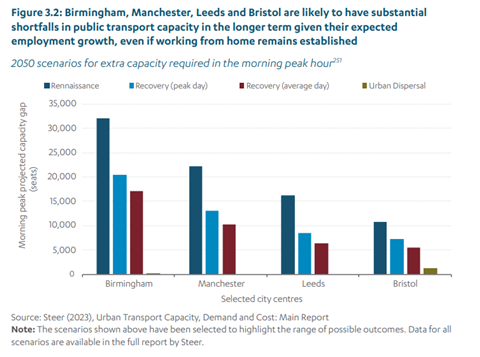With a total of 46 recommendations across 222 pages, it’s no surprise the report took two years to compile. ��ɫ����TV sifts through the key points

Much more investment is needed, but private backers will demand stability
The NIC was not shy in its headline ask from government. Put simply, it said, the UK needs a big injection of cash to fix its infrastructure over the coming decades. £30bn a year from the taxpayer to be exact, with a further £40bn to £50bn a year from the private sector.
This level of investment, which the commission said should be sustained until 2040, is right at the top of the fiscal remit set for it by the Treasury (1.3% of GDP per year).
In comments that read as a gentle indictment of recent governing practice in this country, the report noted that to attract the level of private investment necessary, the UK would need to institute greater policy stability and speed up the planning system for major projects – particularly energy transmission schemes – with regularly updated National Policy Statements.
Responding to the report on Wednesday, James Corrigan, the UK managing director for infrastructure at Turner & Townsend, said this call for long-term certainty could fall on deaf ears among politicians, to the frustration of potential private investors.
“The reality is that the industry is bracing itself for a year of political push and pull as we head towards a general election,” he said.
“Political commitment and consensus is absolutely critical if we are to make headway on the NIC’s recommendations not just in the year ahead, but the decades to come,” added Corrigan, arguing that the rise in private investment necessary would only come “if the UK can reassure funders that there is a plan and we are sticking to it”.
He added: “The construction sector itself sits in the same bracket. It is the engine behind the changes we need to see but the industry is fragile and the scale of the challenge is immense – made all the more difficult by soaring insolvencies, sticky inflation and tight taxpayer and household budgets. A clear pipeline of programmes and funding is more needed than ever to build confidence and maintain a supply chain which can deliver on ambitions.”
Review is needed after HS2 cuts, but the pandemic has not changed case for rail
On the topic of certainty, NIC chairman Sir John Armitt described his “disappointment” at the government’s choice to cut HS2 in a briefing to journalists on NIA2.

One of the points the government has made in the wake of its HS2 decision is that changes in rail use post-pandemic had changed the business case. The NIC agreed that passenger numbers on public transport had declined and remained below pre-pandemic levels but noted that the resulting dent in revenues could result in a “doom loop” for public transport, with underinvestment leading to further reductions in patronage.
It said that despite the change in working patterns, projected passenger numbers would demand increased capacity in a number of major cities over the coming decades and that the government should be ready with a plan to invest in mass transit systems.
The commission recommended a total investment of £22bn in public transport, with two-thirds going to major schemes in Manchester, Birmingham, Leeds and Bristol and the remaining third going to smaller schemes elsewhere, with Liverpool, Sheffield, Norwich and Coventry cited as potential recipients.
Read more: ’Urgent’ review of rail plans needed after confidence hit by HS2 cut, says Armitt
Call to restrict motorists will create tension with Sunak administration
It is not just HS2 on which the commission has contradicted the government. Sunak’s HS2 U-turn was accompanied with a new rhetoric pitching his administration as fighting on the side of motorists against local authorities implementing traffic management schemes which it claims are draconian, despite central government having helped encourage many of these policies only a few years ago.

While NIA2 did argue in favour of repairs to the UK pot-holed roads, it also made it clear that it believed measures such as congestion charging would be needed to encourage a modal shift towards public transport and stop too many people driving into cities. The report said:
“Investment in public transport alone will not be sufficient to reduce congestion and improve capacity. Cities will also need to reduce car journeys into congested city centres, especially at peak times.
“Measures such as congestion charging and workplace parking levies can reduce car use, thereby freeing up room on the roads for more public transport. The sequencing of these transport changes will be important as reducing trips by car where there is no viable public transport alternative risks hindering, not supporting, growth and having negative social impacts.”
Meanwhile, on the opposition benches, one can only imagine Starmer, Reeves and co are rubbing their hands together as they read through the report. The £30bn figure issued by the NIC is strikingly similar to Labour’s £28bn promise to invest in meeting net zero, which has been repeatedly ridiculed by the Conservative party as unaffordable. The commission, it would appear, believes it is unaffordable not to spend at this level. Recommendations to simplify the planning process for major projects also chime well with promises made in the shadow chancellor’s speech at the Labour party conference last week in Liverpool.
In fact, the party has come out publicly to welcome the NIC’s report, claiming it is an endorsement of its own policies. “The National Infrastructure Commission’s report backs Labour’s plans to get Britain building again,” said Darren Jones, shadow chief secretary to the Treasury, in a statement. “There is no doubt we need a transformation in the UK’s approach to infrastructure to drive investment and growth across Britain. However, after 13 years of economic failure and stagnation, the biggest obstacle to this report’s recommendations being implemented and to get our economy growing is the Conservative party.”
Households should be supported with heat pump transition to unlock future savings
Seven million buildings in England need to make the transition to heat pumps and heat networks by 2035 which will require a 35% annual growth rate in installations. The challenge is big and Armitt did not mince his words when assessing current progress on meeting it.
“We have got a 2035 target that is only 12 years away and I find it hard to accept that we are likely to meet that when we are installing 50,000-60,0000 […] heat pumps per annum at the moment, when the government has set itself a target of 600,000 heat pumps a year by 2028,” he said earlier this week. “It is not cutting the mustard at the moment, so therefore there has to be a significant improvement to achieve that 2035 [target].”

The NIC recommended a major programme of investment into electrification, including an offer of £7,000 to homes to switch to the technology. This would help homes buy heat pumps while they remain expensive, with the subsidy designed to taper off as the cost of the technology falls.
It also recommended an investment of £3.2bn a year to 2035 to improve energy efficiency and install heat pumps across the public sector estate and social housing and £1.3bn a year to 2035 to cover the full cost of installation for lower income households.
It was clear, however, that it did not believe hydrogen had a role to play in heating homes, despite the arguments of heat pump sceptics. On all of the metrics the commission used – which included price, environmental benefits and resilience – it scored neutrally or negatively compared with heat pumps. But it did back the use of hydrogen as a tool for heavy industry to cut emissions and proposed a multi-billion pound project to link industrial clusters across the country with a network of pipelines.
While the investments suggested by the NIC would be expensive upfront, they could save the average household at least £1,000 a year in the long-run, the organisation claims.
>> Read more: Infrastructure body backs massive heat pump roll-out but spurns hydrogen
New focus on energy security in aftermath of Ukraine war chaos

The recommended shift towards electrification puts even more pressure on an electricity system that has proven incredibly vulnerable to geopolitical uncertainties. The report explained:
“The electricity system will become even more important as the rest of the economy electrifies and so needs to be underpinned by a new strategic energy reserve. The energy system has proven to be vulnerable to price shocks such as that caused by Russia’s illegal invasion of Ukraine. Part of the reason it was so exposed was because it did not have adequate gas reserves that could be used to mitigate the impact of the shock. Government should establish a reserve of energy that can be released into the market to generate electricity in order to mitigate the effect of price shocks in the future.”
It recommended legislation be introduced to give the secretary of state powers to establish and control this strategic reserve and that the government take action to develop a reserve that could be used to generate 25TWh of electricity in 2040 and to maintain it at this level after that.
The NIC’s modelling suggests that, by 2035, 60GW of short-term flexible capacity will be needed to provide a low-cost electricity system, a massive increase from the roughly 15GW currently online. 30TWh of longer-term persistent flexible generation will also be needed to manage the potential for prolonged shortfalls during winters that are colder and less windy than average.
It anticipates that this flexible capacity will be best supplied by a mix of hydrogen fired generation and gas generation with carbon capture and storage – however it recommended that unabated gas fired generation should be phased out to less than two per cent of electricity by 2035. At least eight TWh of hydrogen storage capacity will be needed to achieve this and the commission recommended government put in place a business model to support hydrogen fired generation.


























1 Readers' comment